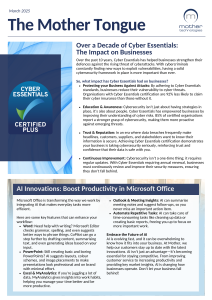Any business that relies on technology must have an IT disaster recovery plan in place. Natural disasters, cyber attacks, hardware failures, and human errors all pose threats to technology systems and infrastructure. Each company is unique in terms of how it operates and stores and uses data. However, here are some of our general guidelines.
An IT disaster recovery plan (DRP) is a detailed document that outlines the steps an organization should take to restore its critical IT systems and functions in the event of a disaster. It ensures minimal disruption and rapid recovery of vital technology resources.
Downtime: Without a disaster recovery procedure, a business may experience extended downtime in the event of an IT disaster. This can lead to lost profits, decreased productivity, and poor customer experience. As per Veeam’s 2022 Data Protection Report, for example, the average cost of downtime to businesses is $1,467 per minute.
Data loss: Critical data, such as customer information, financial records, and intellectual property, can be lost as a result of an IT disaster. This loss can have serious financial and legal repercussions for a company.
Security breaches: Security breaches are a real threat that can arise in the aftermath of an IT disaster. Such disasters could leave a business more vulnerable to cyber attacks, which can compromise sensitive data and harm the company’s reputation. Within this, there is the risk of ransomware attacks. The number of businesses that have fallen victim to ransomware attacks has grown drastically in the last couple of years, with ransomware accounting for 20% of all cyber crimes in 2022.
Legal and regulatory issues: Based on the nature of the data lost or compromised, an organisation may violate legal and regulatory requirements, which could result in fines and other legal implications.
As a whole, the dangers of not having an IT disaster recovery plan are significant. Serious consequences for a company’s financial stability, legal compliance, and reputation could arise.
An effective IT disaster recovery plan is a detailed and well-thought-out strategy. It enables a business to recover from unforeseen events that disrupt its IT systems and infrastructure. Here are some core elements that make a successful disaster recovery plan.
Risk Assessment: A thorough risk assessment is an effective beginning to a disaster recovery plan. This assessment must recognise the possible threats and vulnerabilities that a business may face. This enables the organisation to prioritise its resources and develop risk-mitigation strategies.
A well-defined recovery objective: The recovery objective should be clearly outlined in the disaster recovery plan. This recovery objective is the desired state of IT systems and infrastructure after a disaster. This goal should be realistic, attainable, and in line with the overall goals of the company.
Prioritisation of critical systems and data: To minimise the impact of a disaster on business operations, a disaster recovery plan should be created. This plan should identify and prioritise vital systems and data. These are to be recovered immediately.
Regular testing and updating: To remain relevant and successful an effective disaster recovery plan must be tested and updated regularly. Frequent testing should be performed to identify any flaws or areas for improvement in the plan. Updates should be made as necessary to reflect changes in the business’s IT systems and infrastructure.
Clearly defined roles: The disaster recovery plan should clarify the roles and responsibilities of key employees involved in the recovery process. This ensures that everyone knows what they need to do in the event of a disaster. There will be no confusion or duplication of labour.
Backup Strategies: An efficient disaster recovery strategy should include plans for unpredicted events that may occur during the recovery process. This involves having backup procedures in place in case the original recovery plan fails. Additionally, a communication plan should be in place to keep all stakeholders updated throughout the recovery process.
Mother provides comprehensive disaster recovery plans to help your business quickly and securely recover from any disaster. Our tailored plans protect your IT systems and allow you to focus on other aspects of your business with peace of mind.
Our disaster recovery plans offer a wide range of options to quickly restore your critical IT systems and minimise downtime. Our expert team works with you to develop a customised plan that is regularly tested and updated. Trust Mother to provide reliable and scalable protection for your business.

Read the newest edition of The Mother Tongue, packed with fresh tech insights and company updates.
